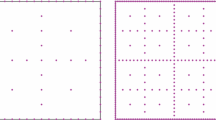Abstract
The calculation and implementation of the neighboring optimal feedback control law for multiinput, nonlinear dynamical systems, using discontinuous control, is the subject of this paper. The concept of neighboring optimal feedback control of systems with continuous, unbounded control functions has been investigated by others. The differentiating features between this class of problems and that considered here are the control discontinuities and the inherent system uncontrollability during the latter stages of the control-law operating time.
The neighboring control law is determined by minimizing the second-order terms in the expansion of the performance index about an optimal nominal path. The resulting gains are a function of the states associated with the nominal trajectory. The development of a feedback control scheme utilizing these gains requires a technique for choosing the gains appropriate for each neighboring state. Such a technique is described in this paper. The technique combines abootstrap algorithm for determining the number of neighboring switch times and the initial and final controls with a scheme based ontime-to-go along the nominal and neighboring paths until the next predicted switch time or the predicted final time. This scheme requires that the nominal state, which is used to specify the feedback gains, be chosen such that the predicted time-to-go from the neighboring state be identical to the time-to-go from the nominal state. This technique for choosing feedback gains possesses minimal storage requirements and readily leads to a real-time feedback implementation of the neighboring control law.
The optimal feedback control scheme described in this paper is utilized to solve the minimum-time satellite attitude-acquisition problem. The action of the neighboring control scheme when applied to states which do not lie in an immediate neighborhood of the nominal path is investigated. For this particular problem, the neighboring control scheme performs quite well despite the fact that, when the state perturbations are finite, the terminal constraints can never be satisfied exactly.
Similar content being viewed by others
References
Foerster, R. E., andFlügge-Lotz, I.,Neighboring Optimal Feedback Control of Multi-Input Nonlinear Dynamical Systems Using Discontinuous Control, Stanford University, Aero-Astronautics Sudaar No. 398, 1970.
Breakwell, J. V., Speyer, J. L., andBryson, A. E.,Optimization and Control of Nonlinear Systems Using the Second Variation, SIAM Journal on Control, Vol. 1, No. 2, 1963.
Kelley, H. J.,Guidance Theory and Extremal Fields, IRE Transactions on Automatic Control, Vol. AC-7, No. 5, 1962.
Speyer, J. L., andBryson, A. E.,A Neighboring Optimum Feedback Control Scheme Based on Estimated Time-to-Go with Application to Reentry Flight Paths, AIAA Journal, Vol. 6, No. 5, 1968.
Powers, W. F.,Technique for Improved Convergence in Neighboring Optimum Guidance, AIAA Guidance, Control, and Flight Mechanics Conference, Princeton, New Jersey, Paper No. 69-888, 1969.
Dyer, P., andMcReynolds, S. R.,On a New Necessary Condition for Optimal Control Problems with Discontinuities, Jet Propulsion Laboratory, Space Programs Summary No. 37–48, Vol. 3, 1967.
Dyer, P., andMcReynolds, S. R.,On Optimal Control Problems with Discontinuities, Journal of Mathematical Analysis and Applications, Vol. 23, No. 3, 1968.
Jacobson, D. H.,Differential Dynamic Programming Methods for Solving Bang-Bang Control Problems, IEEE Transactions on Automatic Control, Vol. AC-13, No. 6, 1968.
Bullock, T. E.,Computation of Optimal Controls by a Method Based on Second Variations, Stanford University, Aero-Astronautics Sudaar No. 297, 1966.
McIntyre, J. E.,Neighboring Optimal Terminal Control with Discontinuous Forcing Functions, AIAA Journal, Vol. 4, No. 1, 1966.
McNeal, D.,Neighboring Optimal Control of Nonlinear Systems Using Bounded Control, Stanford University, Aero-Astronautics Sudaar No. 311, 1967.
Dyer, P., andMcReynolds, S. R.,Optimization of Control Systems with Discontinuities and Terminal Constraints, IEEE Transactions on Automatic Control, Vol. AC-14, No. 3, 1969.
Pontryagin, L. S., Boltyanskii, V. G., Gamkrelidze, R. V., andMishchenko, E. F.,The Mathematical Theory of Optimal Processes, John Wiley and Sons (Interscience Publishers), New York, 1962.
Bryson, A. E., andHo, Y. C.,Applied Optimal Control: Optimization, Estimation, and Control, Blaisdell Publishing Company, Waltham, Massachusetts, 1969.
Busch, R., andFlügge-Lotz, I.,The Attitude Control of a Satellite in an Elliptic Orbit, Journal of Spacecraft and Rockets, Vol. 4, No. 4, 1967.
Wolske, G. D., andFlügge-Lotz, I.,Minimum Fuel Attitude Control of a Nonlinear Satellite System with Bounded Control by a Method Based on Linear Programming, Stanford University, Aero-Astronautics Sudaar No. 374, 1969.
Author information
Authors and Affiliations
Additional information
Communicated by J. V. Breakwell
This research was sponsored by the National Aeronautics and Space Administration under Research Grant No. NGL-05-020-007 and is a condensed version of the investigation described in Ref. 1. The authors are indebted to Professor Arthur E. Bryson, Jr., for suggesting the topic and providing stimulating discussions.
Rights and permissions
About this article
Cite this article
Foerster, R.E., Flügge-Lotz, I. A neighboring optimal feedback control scheme for systems using discontinuous control. J Optim Theory Appl 8, 367–395 (1971). https://doi.org/10.1007/BF00929287
Received:
Revised:
Issue Date:
DOI: https://doi.org/10.1007/BF00929287



